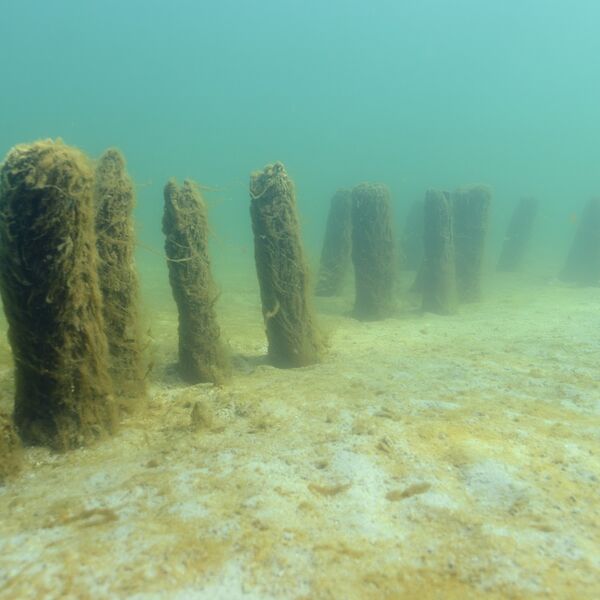Prähistorische Pfahlbauten um die Alpen
Marc-Antoine Kaeser
Direktor des Laténium, Park und Museum für Archäologie in Neuenburg
Welches ist Ihre Rolle in Bezug auf die prähistorischen Pfahlbauten?
Im Laténium (Neuenburg), dem grössten archäologischen Museum der Schweiz, tragen wir natürlich eine sehr grosse Verantwortung für die Erschliessung der Fundstellen am See, wo hunderttausende von Objekten entdeckt wurden. Diese werden heute in unseren Depots aufbewahrt. Wir arbeiten eng mit Forschern der kantonalen Dienststelle und mit dem universitären Institut zusammen, die ihre Büros und Labors ebenfalls im Museum haben. Diese Synergien bilden eine sehr solide Grundlage für den Austausch mit der Öffentlichkeit, den wir so umfassend wie möglich gestalten wollen. Neben Geschichtsinteressierten richten wir uns auch an Kinder, Familien und Touristen. Die moderne Museografie sowie die farbenfrohe und helle Gestaltung unserer Dauerausstellung machen die Archäologie für jeden attraktiv.
Wie sind Sie zum Laténium gekommen?
Ich habe hier, in Paris und in Harvard (USA) studiert, bin für die Arbeit in der Schweiz viel gereist und reise oft ins Ausland, um dort zu lehren und zu forschen. Aber hier im Laténium werden alle Kräfte gesammelt, die einen Archäologen glücklich machen! Und um ehrlich zu sein, ist die Arbeit vor einem solchen Panorama unersetzlich. Dazu muss man sagen, dass ich ein Liebhaber des Neuenburgersees mit seinen ganz besonderen Farbbewegungen bin. Im Sommer mache ich oft eine kurze Pause, um zwischen zwei Sitzungen ein Bad zu nehmen: ein paar Dutzend Meter von meinem Büro entfernt bade ich in einem zeitlosen Universum und betrachte die Alpen in der Ferne...
Was fasziniert Sie am meisten an den Pfahlbauten?
Der Reichtum und die ausserordentliche Vielfalt der erhaltenen Objekte, die uns oft sehr berührende Details aus dem täglichen Leben unserer fernen Vorfahren aus der Jungsteinzeit und Bronzezeit erzählen. Natürlich gibt es auch Waffen und fein gearbeitete Ornamente, die aus kostbaren Materialien hergestellt und aus tausenden von Kilometern Entfernung importiert wurden. Was mich aber am meisten fasziniert, sind die Weidenkörbe, die Äpfel und Haselnüsse, der bescheidene Löffel oder das über 3000 Jahre alte und perfekt erhaltene Holzspielzeug: Wenn man sie anschaut, hat man den Eindruck, dass das Dorf erst vor wenigen Tagen von seinen Bewohnern verlassen wurde!
Was empfehlen Sie besonders?
Es gibt 56 Pfahlbau-Fundstellen in der Schweiz, die zu diesem Welterbe gehören: Es ist unmöglich, sie alle zu sehen! Natürlich können Sie sie mit der mobilen Anwendung "Palafittes Guide" allein auf Ihrem Smartphone erkunden. Aber der überraschendste und direkteste Zugang ist meiner Meinung nach das "Archäologische Fenster" beim Opernhaus im Zentrum von Zürich: Wenn man in die Tiefgarage hinuntergeht, taucht man dank Filmprojektionen und einer kleinen Ausstellung plötzlich in die Urgeschichte ein. Ansonsten würde ich empfehlen, einige Stunden im rekonstruierten Seedorf Gletterens (Freiburg) zu verbringen, wo regelmässig Workshops und Vorführungen angeboten werden, die eine sehr konkrete Vorstellung vom Leben in einem neolithischen Dorf am Neuenburgersee vermitteln. Und natürlich empfehle ich einen Besuch im Laténium (Neuenburg), das mit dem Museumspreis des Europarates ausgezeichnet wurde. Das Museum bietet eine sehr schöne und umfassende Ausstellung in einer idyllischen Umgebung mit rekonstruierten Pfahlbauhäusern im archäologischen Park am See.
Ein Geheimtipp?
Nehmen Sie das Boot vom Hafen im Stadtzentrum von Neuenburg, um zum Laténium zu gelangen: die Fahrt dauert 15 Minuten und ist kostenlos... Oder gehen Sie an der Seepromenade entlang; am besten verlassen Sie den Bahnhof in Saint-Blaise/Lac. Die Ufer sind sehr schön gestaltet, mit einem kleinen Teich, Sandstränden, Buchten und Bächen, die eine sehr reiche Vegetation und Fauna beherbergen: es sieht fast wie eine prähistorische Naturlandschaft aus!
Mai 2016








